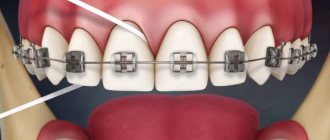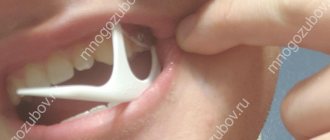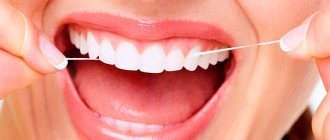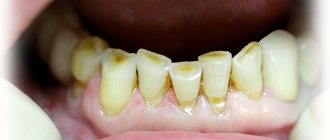What is floss and how to use it correctly
Floss is used to cleanse the interdental space, remove food debris and plaque particles from the mouth and prevent the formation of tartar. If the brush mainly cleans the front walls of the teeth and gums, the target of dental floss is the space between the teeth where the brush cannot reach. This is an effective prevention of many diseases and reliable assistance in the fight for cleanliness.
Floss is made from silk, nylon, nylon or acetate fibers, has a special weave and special impregnation for improved glide, as well as additional treatment with a medical composition. Which material to choose is not so important, but it is better to first consult with your dentist.
This simple device performs several important tasks at once:
- normalizes the acid balance in the mouth, thereby counteracting the development of diseases and demineralization of teeth;
- prevents the formation of an unpleasant odor - effectively removes food debris and plaque, along with bacteria, no bacteria - no odor;
- prevents the formation of caries, gum disease and other oral diseases.
But floss is only effective if it is used correctly. Basic recommendations and tips on how to use dental floss correctly:
- Before the procedure, be sure to wash your hands with soap;
- for effective teeth cleaning, a piece of thread about 20-30 cm long is required;
- the ends of the segment are wound around the middle fingers of both hands;
- the thread is pulled between the index finger and thumb;
- place the stretched floss between two adjacent teeth;
- we move the floss between the teeth, moving it up or down, gradually approaching the gums, avoiding too fast or sudden movements and jerks, so as not to damage the tooth enamel or soft tissues;
- we pull it around the tooth in a semicircle (to form the letter “c”) and move it back and forth several times, 7-8 movements are enough;
- Without removing the floss from the interdental gap, we wrap the adjacent tooth in the same way and repeat the cleaning;
- We repeat the procedure with all teeth, including the distant ones - this is where, as practice shows, the most bacteria accumulate and it is the most difficult to reach during hygiene procedures, so you should spend a little more time on the outermost lateral teeth.
At first, without experience and practice, it is not easy to perform the procedure, so at first it will take quite a lot of time. But after a few days you will get used to it and will perform it automatically, easily and quickly.
Important: to clean each subsequent tooth, you should use a clean section of the floss, otherwise you will not clean the oral cavity, but will transfer dirt and bacteria from the affected area to the healthy one. The meaning of the procedure in this case is simply lost.
Under no circumstances should you replace floss with regular threads - they have a rougher surface and can damage the tissues of the oral cavity.
Alternative options
Sometimes people never learn how to brush their teeth with floss. If you find it difficult to floss, try waxed floss, which glides more easily between your teeth, or try alternative interdental cleansers. Such devices include dental floss in plastic holders (flossers) and interdental brushes (thin brushes). You can also find electric irrigators at the pharmacy. These devices clean the spaces between teeth using a stream of water supplied under pressure. The irrigator effectively removes food debris and reduces the amount of bacteria under the gum line, but dentists warn that it cannot replace a toothbrush and only serves as an addition to it, like dental floss.
So how often should you brush your teeth with dental floss? The answer is simple: daily. Do it right - if you have difficulty flossing, your dentist or dental hygienist can show you how to use it or recommend another interdental cleaning device that is more suitable for your needs.
When and how often should you floss?
If we're talking about how to properly floss between teeth, it's best to figure out how often you should do it in order to achieve cleanliness without harming your teeth and gums.
You need to floss at least once a day - before bed, immediately after brushing, when the main contaminants have already been removed from the surface of the crowns. Although many dentists believe that it is wiser to floss first, so you can set the order of procedures yourself.
Ideally, you should brush every time after eating. The main thing is not to overdo it - you shouldn’t floss after every snack or casually eaten piece of food; a special mouth rinse from the pharmacy is more suitable for these purposes. Flossing too often can backfire and damage your tooth enamel or gums.
Even children over 8 years old can use floss; it is absolutely safe and does not contain harmful substances or compounds. But at first, cleaning should be done under adult supervision.
How to choose a brush
At first glance, all dental brushes seem the same - small brushes with multi-colored handles. But each of us has different spaces between our teeth, which means it is important to choose your brush size. This is important because if the brush is smaller than your interdental space, it will not be able to completely remove plaque. If it is larger, it may injure the gums, or, most likely, will not pass into the gap.
It is impossible to understand right away how long the bristles you need in a brush. First you will need to take measurements. Today this is possible at home, using a special probe.
The most convenient probe for such purposes is the Curaprox IAP prime probe. This is a small stick that is divided into 5 color zones. Each zone corresponds to the size and length of the brush head and corresponds to the color of the handle of a particular brush from the Curaprox Prime line. The probe can be purchased separately or in a set with several brushes.
The entire measurement procedure will take a few seconds and guarantees 100% accuracy in the selection of hygiene products based on your individual parameters. Usually, brushes are not used between the incisors (remember, there are threads for this), so after purchasing a probe, measure each distance between the chewing teeth. In one place the interdental distance will be greater, in another less. Based on this measurement, mark the sizes of brushes you need.
If you are just going to start using brushes, it is worth purchasing a starter set with different sizes. This, again, is available from Curaprox.
When should you not use dental floss?
Floss is considered one of the simplest and safest hygiene tools; it is simple and inexpensive to use, just a few minutes of free time is enough. However, even this device has contraindications. It cannot be used in the following cases:
- if your gums are bleeding, you can aggravate the situation and introduce an infection into the soft tissues;
- with periodontal disease - floss can damage weakened gums, provoke bleeding and even inflammation, plus there is a risk of infection on neighboring dental units;
- in the presence of caries - the disease weakens the teeth, makes them brittle and brittle; if floss is used carelessly, fragments may break off from the affected tooth, therefore, before purchasing floss, it is highly advisable to treat the entire oral cavity;
- for any inflammatory diseases of the oral cavity during the period of exacerbation;
- You cannot floss crown and bridge prostheses - there are special threads for such structures.
If you know how to properly brush your teeth with dental floss and use it along with toothpaste and brush, you can achieve excellent results: a charming smile and fresh breath will delight you every day.
Indications for use
Dental floss is indispensable for cleaning narrow interdental spaces, crowded teeth, and various dental diseases that arise due to the proliferation of bacterial agents in the oral cavity.
In addition, flosses are necessary for dental care after the installation of approximal fillings, especially those made of composite materials. The fact is that it is quite difficult to polish the proximal surfaces of fillings, and only with the help of floss can you prevent the formation of tartar on a not entirely smooth surface.
Flosser
Some people find flossing inconvenient, especially outside the home. In this situation, it is worth paying attention to special devices that simplify this procedure - flossers.
There are two types of flossers on sale, differing in design and principle of operation:
- Manual flosser It is a plastic holder with a synthetic thread stretched between the edges.
This device can be either disposable or with replaceable fiber. Despite the fact that such a device can always be carried with you and used after every meal, it has several disadvantages.The standard thickness of the floss can cause discomfort for people with small interdental spaces. In addition, the design of the flosser does not allow removing plaque from the cervical area.
- Electromechanical flosser consists of two elements - a plastic case in which the motor mechanism is located, and a special bleaching tip.
When the device is turned on, the removable nozzle makes up to 10 thousand rotations per minute, delicately removing bacterial plaque from the gum pockets and interdental space.In addition, the vibrations produced by the device help strengthen the gums and improve their trophism. The electric flosser operates on batteries and has up to 15 nozzles included.
To learn about what types of dental floss there are and for what purposes each type is used, see the video.
Kinds
There are several types of floss.
Each of them is designed to perform a specific task, taking into account the width of the interdental spaces, the condition of the gums and enamel. When deciding which floss to purchase, first of all, you need to understand for what purposes it is needed - preventive or therapeutic:
- Prophylactic threads are not impregnated and are intended for daily use to eliminate plaque in the absence of diseases of the enamel and gums.
- Therapeutic threads use special impregnation , which has antibacterial and anti-inflammatory effects. Depending on the goal that needs to be achieved, you can select flosses treated with special compounds based on mint, menthol, chlorhexidine and other drugs.
An equally important factor is the material from which the floss is made. All commercially available dental flosses are divided into three groups:
- Silk. They have a small thickness and high cleaning properties. However, due to the heterogeneous fibrous structure, such products are not recommended for use by people with orthodontic structures, fillings or various prostheses. The thread may touch the protruding parts of the devices and delaminate.
- Nylon. Flosses are made from many synthetic fibers woven into one thread. Such products are very durable and can be used with installed orthodontic structures. Also, people with small interdental spaces should pay attention to nylon threads.
- Teflon. Threads made from this material have high strength due to the fusion of several fibers into a single whole, therefore they are often used in the presence of orthodontic or orthopedic systems.
Some manufacturers offer threads that increase in volume under the influence of saliva. Such products efficiently remove plaque in a small space between the molars, without damaging the gums.
Types of dental brushes and rules for their use. Let's look at the popular models of Splat toothbrushes here.
At this address https://dentist-pro.ru/krasota-i-uxod/sredstva/zubnye-shhetki/komfortnaya-i-kachestvennaya-zabota-o-polosti-rta-s-elektricheskoj-oral-bi.html you will find detailed description of the Oral Bee Vitality electric toothbrush.
By shape
Considering the anatomical structure of the dentition, it is worth paying attention to the shape of the thread. There are two common varieties:
- The round floss has a standard cross-section and is designed to remove plaque from people with medium-width interdental spaces. Dentists often recommend using this particular floss due to its high contact with the surface being treated.
- Flat floss has a minimum thickness, as a result of which it can be used in cases of high crowding of teeth and small space between them. The large width of the product ensures maximum coverage of the molar area and high-quality removal of bacteria.
By surface type
When choosing floss for the first use, it is important to decide on the type of its surface:
- Waxed products are coated with special wax, so they do not flake and glide easily, preventing damage to the gums. Such threads are intended for teaching hygiene procedures using threads.
- Unwaxed flosses break apart into small fibers during use, providing maximum contact with the tooth surface. By increasing the friction force, plaque is removed more quickly and efficiently. Dentists recommend wax-free products when you already have the skills to use floss.
Cleaning technique
This method is suitable for all types of threads: waxed, twisted, synthetic, sponge. Unwind a certain amount (20-40 cm) of thread and secure with your fingers. Use your thumbs to place the floss between your upper teeth and your index fingers between your lower teeth. Do not press the floss too hard, but apply tension to more thoroughly clean between the teeth and the sides of the teeth.
Each interdental space must be cleaned using a fresh piece of floss. It is necessary to treat both the internal and external surfaces, as well as the surfaces of the posterior teeth on both jaws.
Advantages
The procedure for using thread has a number of undeniable advantages:
- an affordable and fairly common remedy;
- effectively removes plaque and small food particles;
- completely cleans the interdental space;
- ease of use;
- the variety of shapes and materials allows you to choose the best option for yourself;
- strong and does not tear when used;
- applied impregnations disinfect the oral cavity and strengthen tissues;
- prevents the development of gum disease, inflammation, bleeding, and the formation of tartar;
- It is possible to perform oral hygiene anywhere without toothpaste and water.
Most of the benefits listed appear only after regular use of the thread. Therefore, it is important to get into the good habit of using it at least once a day to perform oral hygiene.










